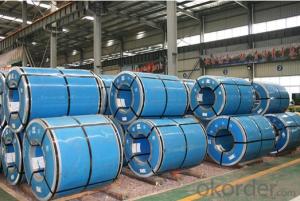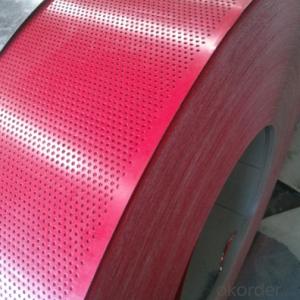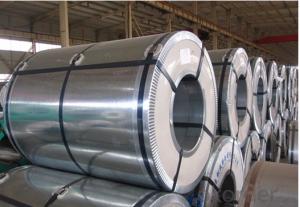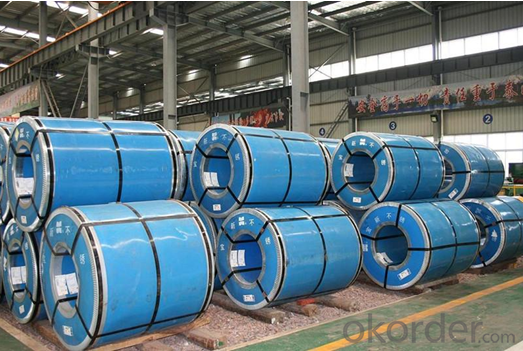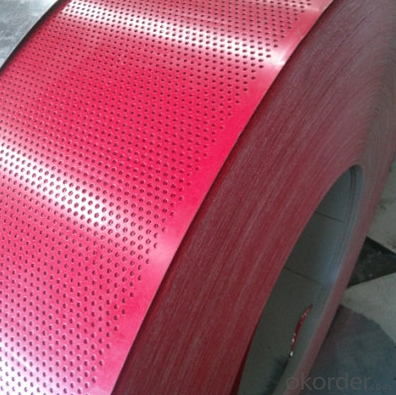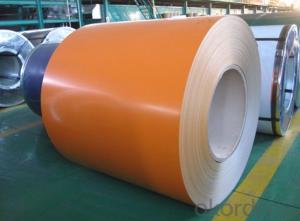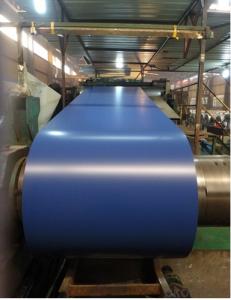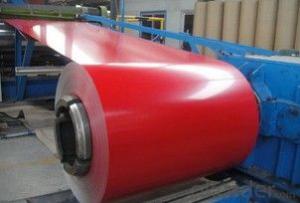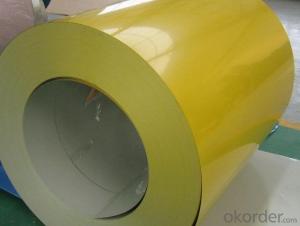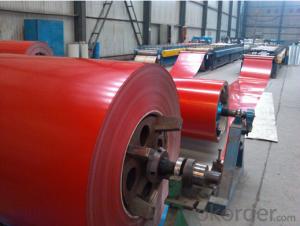Hot-Dip Galvanized Steel/Pre-Painted Steel Coil for Tiles
- Loading Port:
- China main port
- Payment Terms:
- TT OR LC
- Min Order Qty:
- 50 m.t.
- Supply Capability:
- 1000000 m.t./month
OKorder Service Pledge
OKorder Financial Service
You Might Also Like
Specifications;
1. Aluzinc coating mass: 30g-275g/sqm
2. Coil weight: 4-6 tons per coil
3. Edge treatment: Mill edge or cut edge.
4. Technical treatment: Bright annealed, flatting, cold harden.
5. Surface treatment: Annealed, bright finish, dull/bright finish, slit edge.
6. Spangle: Normal/small/big/zero spangle.
7. Delivery terms: FOB / C&R / CIF
8. Supply Ability: 30000MT/month
9. Application: The construction industry: The roof structure, keel, grill, Clapboard, ceilings, fire shutter doors, etc; The light industry, the Automobile, agriculture, animal husbandry, fishery, casing of household Electronic application, civilian smoke stack, etc.
10. Delivery time: Within 30 days after the receipt of L/C or Signed the contract or according to customer's requirement.
Special design available according to requirement; Anti-corrosion And high-temperature resistant with black painting; All the production process Are made under the ISO9001: 2000 strictly

commodity Brick pattern Color Galvanized Steel Sheet (PPGI/ PPGL) Techinical Standard: JIS G3312-1998, EN101169, ASTM A755 grade TSGCC, TDX51D / TDX52D / TS250, 280GD Types: For general / drawing use Base metal galvanized, galvalume Thickness 0.14-3.0mm(0.16-0.8mm is the most advantage thickness) Width 610/724/820/914/1000/1200/1219/1220/1250mm Type of coating: PE, SMP, PVDF Zinc coating Z60-275g/m2 or AZ40-150g/m2 Top painting: 5 mic. Primer + 15 mc. R. M. P. Back painting: 5-7 mic. EP Color: According to RAL standard ID coil 508mm / 610mm Coil weight: 4--8MT Package: Properly packed for ocean freight exportation in 20' ' containers Application: Industrial panels, roofing and siding for painting / automobile Price terms FOB, CFR, CIF Payment terms 20%TT in advance+80% TT or irrevocable 80%L/C at sight delivery time 25 days after recepit of 20% TT Remarks Insurance is all risks MTC 3.1 will be handed on with shipping documents We accept SGS certificatation test PPGI,(PPGL,pre-painted galvanized steel coils, pre-painted galvalume steel coils,color coated steel coils.color coated galvanized steel coils)
1, Introduction: PPGI is made of galvanized steel coils or galvalume steel coils with polymer coatings as surface. It's a new enclosure material and building board
2, Product feature: Apperance of a variety of color Antirust and antiseptic,durability,etc.
3, Production Process: Pretreatment(Degreasing) DryingChromatingPaint Basic OilCoolingDryingColor CoatingCoolingFilm- coveringRolling Up
4, Application: it is ideal for a wide range of applications,, such as pre-engineered buildings, architectural panels, roofing, siding, cladding, and many other building components.and also used back plate of appliance; wide range of construction, furniture industry, transportation industry, etc.
FAQ
1.Do you have QC teams?
Yeah, sure, our QC team is very important, they will keep the quality control for our products.
- Q: How are steel coils used in the production of metal enclosures?
- Steel coils are used in the production of metal enclosures as they provide the raw material needed for forming and shaping the enclosure. The steel coils are processed and cut into sheets or strips, which are then bent, welded, or stamped to create the desired shape and structure of the enclosure. These steel sheets offer strength, durability, and a smooth surface finish to the final product, making them ideal for manufacturing metal enclosures used in various industries such as automotive, electronics, and construction.
- Q: What is the purpose of steel coils?
- The purpose of steel coils is to serve as a form of material storage and transportation for various industries. These coils are typically made by winding steel strips into a circular shape, providing a compact and efficient way to store large quantities of steel. Steel coils are used in numerous applications, such as manufacturing, construction, automotive, and appliance industries, where they can be easily transported, processed, and formed into the desired shape for different products.
- Q: What are the common methods of protecting steel coils from corrosion?
- There exist various techniques commonly employed for safeguarding steel coils against corrosion. 1. Coating: To establish a barrier between the steel coil and the corrosive environment, a protective coating can be expertly applied. Multiple types of coatings, including paint, epoxy, or zinc, are available, each possessing superb corrosion resistance and obstructing the ingress of moisture and oxygen onto the steel surface. 2. Hot-dip galvanizing: Immersing the steel coil in a bath of molten zinc constitutes the hot-dip galvanizing method, resulting in the formation of a substantial zinc coating. This zinc coating acts as a sacrificial barrier, effectively shielding the steel against corrosion. Hot-dip galvanizing is especially advantageous in harsh environments or when prolonged exposure to the outdoors is anticipated. 3. VCI (Volatile Corrosion Inhibitor) packaging: VCI packaging entails encasing the steel coils in specially designed film or paper laced with volatile corrosion inhibitors. These inhibitors vaporize and form a protective layer on the steel surface, effectively preventing corrosion. VCI packaging is commonly employed for short-term storage or transportation of steel coils. 4. Desiccants: Moisture plays a significant role in the corrosion process. Consequently, utilizing desiccants such as silica gel or activated alumina aids in moisture absorption and the maintenance of a dry environment surrounding the steel coils. Desiccants are often combined with other protective methods to enhance corrosion protection. 5. Appropriate handling and storage: Employing proper practices for handling and storage significantly mitigates the risk of corrosion. Steel coils should be stored in a dry environment, distanced from moisture sources. Additionally, clean gloves should be utilized during handling to prevent the transfer of corrosive contaminants. Regular inspection and maintenance of the storage area are crucial for identifying and addressing potential corrosion risks. By employing one or a combination of these methods, steel coils can be effectively preserved against corrosion, guaranteeing their longevity and structural integrity.
- Q: Does the solution change, or does only the steel wool change color?
- Steel is an iron alloy, and iron is more reactive than copper, so what you'd see is the blue colour of the solution becoming lighter, and a black precipitate appearing on the steel wool.
- Q: What is the process of galvanizing steel coils?
- Enhancing the durability and protecting steel coils from corrosion involves a series of steps in the galvanization process. To begin, the steel coils undergo a thorough cleaning to eliminate any dirt, oil, or impurities on the surface. This is achieved through an acid pickling process, where the coils are immersed in a diluted acid solution or treated with a chemical cleaner. The aim is to ensure the surface of the coils is free from contaminants, allowing for better adhesion of the zinc coating. Following the cleaning process, the coils are rinsed to remove any remaining acid or cleaner, preventing adverse reactions in the next stage. The subsequent step involves the actual galvanization, where the cleaned coils are submerged in a bath of molten zinc. To guarantee an even coating, the coils are carefully passed through the zinc bath using rollers or other mechanisms. The zinc bath is maintained at a specific temperature, typically around 450°C (842°F), enabling the molten zinc to bond with the steel surface. Upon withdrawal from the zinc bath, excess zinc is eliminated by passing the coils through air knives or by centrifugal spinning. This ensures control over the thickness of the zinc coating, resulting in a uniform appearance. Once the galvanization process is complete, the steel coils are gradually cooled to room temperature. This facilitates the solidification and firm bonding of the zinc coating with the steel surface, creating a protective barrier against corrosion. The final step involves inspection and quality control. The galvanized steel coils are carefully examined for any defects, such as uneven coating or areas with insufficient zinc coverage. This inspection is typically conducted visually or using specialized equipment capable of detecting anomalies. Additionally, the coating thickness is measured to ensure it meets the required specifications. In conclusion, the galvanization process for steel coils is designed to enhance their longevity and shield them from rust and corrosion. By applying a layer of zinc coating to the steel surface, the coils become more resistant to environmental factors, making them suitable for a wide range of applications across various industries.
- Q: I am doing a experiment on mild steel soaked in sodium chlorideanyone can enlighten me about the effect of the sodium chloride in engineering term ?The mild steel specimen which I soaked in the sodium chloride has orange rust on it
- The mild steel contains a lot of Iron. The NaCl solution quickly attacks the iron content and forms rust. Over time, the solution may also cause what is called 'Chloride Cracking' of the steel. Pitting corrosion of stainless steel due to chlorides would certainly produce a rust-colored product. Passivation can be used to maintain a good corrosion resistant surface of stainless steel process vessel. There are many commercial products for this purpose. In the pharmaceutical industry, this process is often called derouging, that is to remove the buildup of iron oxides on the stainless steel process surfaces
- Q: How are steel coils straightened?
- Steel coils are straightened through a process called leveling, which involves passing the coils through a series of rollers that apply pressure to remove any bends or curves. This process effectively straightens the steel coils, making them ready for further processing or use in various applications.
- Q: Does anyone know what colour steel is?How hard steel is?The density of steel?Conductivity of steel? (Heat and electricity)Reactivity of steel?Melting and boiling points of steel?And the malleability and ductility of steel?Ive looked all over the net and i cant find anything. Can someone please answer these questions or give me a website?THANKS!
- I'm really finding it hard to believe that you've look all over the net and can't find out anything about steel. A Google search on steel turns up 270 MILLION hits, with the first being good, ole, Wikipedia. A quick glance down the article shows up much of what you want. But keep in mind that that steel is not a single substance. There are many different kinds of steels and each has its own properties. Obviously, steel is a metal, so it is a good conductor of heat and electricity. It can be drawn into wires, so it is ductile. It's hard. It's harder than iron. That's the whole point for making steel. The boiling point and freezing points will depend on the type of steel. But please don't insult us by saying you can't find anything about steel. That simply can't be true.
- Q: Explain why a steel nail sinks but a steel ship floats.
- surface area of the ship against the water is much greater than the nail.
- Q: How do steel coils contribute to the packaging industry?
- Steel coils are widely used in the packaging industry as they provide strength, durability, and stability to packaging materials. They are commonly used to produce metal strapping and wire, which are essential for securing and bundling goods during transportation. Additionally, steel coils are used in the production of metal cans and containers, offering a robust and reliable solution for packaging various products.
Send your message to us
Hot-Dip Galvanized Steel/Pre-Painted Steel Coil for Tiles
- Loading Port:
- China main port
- Payment Terms:
- TT OR LC
- Min Order Qty:
- 50 m.t.
- Supply Capability:
- 1000000 m.t./month
OKorder Service Pledge
OKorder Financial Service
Similar products
Hot products
Hot Searches
Related keywords
